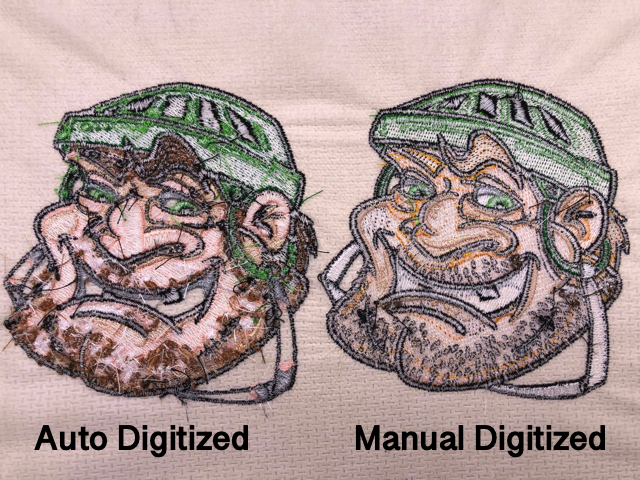Simplifying the Art of Needlework Digitizing: Step-by-Step Overview
Needlework digitizing is a careful craft that demands accuracy and creative thinking. As innovation proceeds to development, the digitization process has ended up being a lot more accessible, permitting fanatics to bring their intricate designs to life effortlessly. In this guide, we will certainly unravel the complexities of embroidery digitizing, damaging down each step carefully to simplify the procedure and equip both newbies and skilled embroiderers alike. Remain tuned to uncover exactly how you can streamline this intricate art kind and transform your innovative visions right into perfectly embroidered work of arts.
Understanding Embroidery Digitizing Software
Embroidery digitizing software functions as a crucial device for transforming intricate designs into electronic styles compatible with needlework equipments, promoting accurate sewing and customization. This customized software application allows users to import numerous photo file formats, such as JPG or PNG, and convert them into needlework machine-readable styles like DST, EXP, or PES - Digitizing for Embroidery. By utilizing features like stitch editing, rug options, and string shade selection, digitizing software program enables users to regulate every element of the design process
Additionally, advanced embroidery digitizing software supplies tools for creating complex styles, readjusting stitch density, and incorporating intricate information. Users can additionally preview the layout before stitching it out, making sure precision and minimizing mistakes. In addition, several software application offer automated functions that assist enhance the digitizing process, saving effort and time.
Recognizing the capacities of needlework digitizing software is necessary for achieving premium lead to embroidery jobs. By mastering this device, embroidery enthusiasts and professionals can release their creative thinking and bring intricate designs to life with accuracy and performance.

Selecting the Right Design Data
After acquainting on your own with the abilities of needlework digitizing software, the following crucial step in the process is selecting the right design apply for your task. Digitizing for Embroidery. When choosing a design documents for needlework digitizing, it's crucial to think about the intricacy of the layout, the dimension of the final product, and the sort of material you will certainly be collaborating with
For detailed layouts with fine information, a high-resolution image or vector data is suggested to guarantee that the embroidery device can properly duplicate the layout. In addition, the dimension of the end product plays a significant role in picking the best layout documents. Larger designs may require higher resolution files to keep clarity and sharpness.
Furthermore, the sort of textile you will be stitching on influences the option of layout data. Different fabrics may call for adjustments in the style data to make sure that the stitches are correctly aligned and the style looks like planned. By carefully choosing the appropriate layout documents based you can look here upon these factors, you can establish on your own up for an effective needlework digitizing procedure.
Digitizing Devices and Techniques
Making use of specialized software and precision strategies, digitizing devices are essential in transforming detailed layouts into embroidery-ready documents. Embroidery digitizing software application, such as Wilcom, Hatch, or Embrilliance, offers the essential platform to convert artwork into stitch data. These programs provide attributes like stitch editing and enhancing, underlay options, and lettering tools to make sure the explanation layout translates perfectly onto material.
One of the key strategies in digitizing is creating a clear course for the embroidery maker to follow. This includes digitizing each component of the style with precision, identifying stitch types, thickness, and instructions. By making use of devices like digitizing tablets or software-specific plugins, embroiderers can achieve a high degree of precision in their digitized designs.
Furthermore, understanding the art of rug stitching is important for producing quality embroidery. Underlay sewing stabilizes the fabric and produces a structure for the style, ensuring that the end product is both visually attractive and long-lasting. By comprehending these digitizing devices and techniques, embroiderers can boost their craft and bring detailed designs to life with accuracy and performance.
Customizing Stitch Kinds and Instructions
The choice of stitch types can dramatically affect the total look and texture of the stitched design. By strategically combining these stitch types, embroiderers can attain deepness and dimension in their designs.
Moreover, the instructions of stitches plays a critical duty in improving the visual allure of the last embroidery. By experimenting with different stitch angles and patterns, embroiderers can bring their designs to life with remarkable detail and intricacy.
Screening and Refining Your Digitized Design
To make sure the accuracy and quality of your digitized layout, detailed testing and improvement are vital actions in the embroidery digitizing procedure. Once you have actually completed the digitization of your layout, it is important to evaluate it before proceeding with the actual needlework. Testing allows you to identify any type of prospective problems such as thread breaks, stitch density issues, or style distortions that may influence the result.

After testing, it is very important to fine-tune your digitized layout based on the comments from the examination sew-out. This might entail tweaking sew settings, adjusting thickness, or making modifications to the total style to attain the preferred outcome. By repeating via screening and improvement, you can tweak your digitized style to excellence prior to moving forward with over here the actual embroidery procedure.
Final Thought
Finally, grasping the art of needlework digitizing needs a thorough understanding of the software application, selecting the right design data, making use of digitizing tools and strategies, personalizing stitch types and directions, and screening and improving the digitized style. By complying with these steps, embroiderers can streamline the digitizing process and develop premium stitched styles with accuracy and effectiveness.